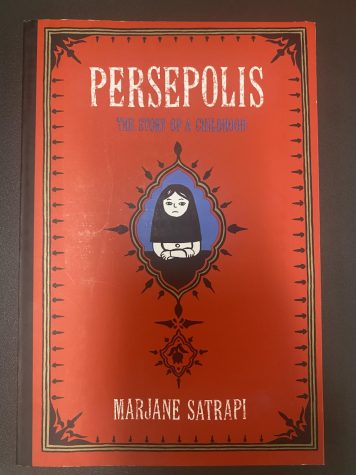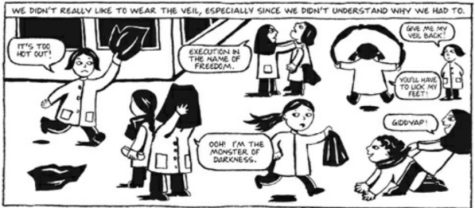Safe Flight, Persepolis
English teacher pilots graphic novel about Iran

When English teacher Gabrielle Scauso first stepped foot into her classroom, a set of books was already sitting there on her desk. “I was under the impression that Persepolis was on the accepted text list,” she said.
Persepolis, a graphic novel by Marjane Satrapi about her experience growing up in Iran during the Iranian Revolution and the Iran-Iraq war is not currently on the school’s approved text list. However, Scauso and librarian Erica Thorsen are working to change that.
Getting a book on the school’s approved text list requires a pilot, meaning that two teachers will create a curriculum surrounding the book and then present the curriculum to the school board for approval.
Scauso said that her English 10 classes found Persepolis to be very engaging.
“I read it all on the first day I got it,” sophomore Lily Hines said. “The subject of the book was fascinating, but I really liked the writer. She could have been all sad, but she was almost funny about it.”
The book covers a time and a place that isn’t often talked about outside of certain history classes. When Scauso asked if students knew what is currently going on in Iran, one student said, ‘I know what’s going on, but I don’t care.” Hearing that motivated Scauso to create a unit on why students should care.
“We’re not taught about the Middle East much in school, even in my AP World class,” sophomore Caroline Funk said. “I feel like we could talk more about parts of the Middle East and parts of Africa.”
Persepolis is relevant to present day Iran due to the nature of conflict between its government and citizens. Scauso believes that being exposed to issues happening around the world, past and present, is important.
According to Thorsen, the publishing industry has had a long-standing issue with diversity in what is published. Despite the issue “getting better,” Thorsen has experienced students sharing the sentiment that the lack of diversity in books is an issue.
While Persepolis would allow students to learn about unfamiliar issues, it can also show students that the events of the book aren’t so foreign after all.

“The current events we’re facing in the United States aren’t that far away or different from events happening elsewhere,” Scauso said.
A common theme in Persepolis is the struggle for women’s bodily autonomy, as well as the intersection of religion into politics. These struggles happen in far more places than just Iran.
According to Scauso, the graphic novel format has helped students understand the content of the story.

“Persepolis was intended to be a graphic novel,” Thorsen said. “I don’t think you would get the richness of the story if you just had the text.”
The symbolism in the images provide insight into the childlike, yet aware, mind of Marji.
“In your lifetime, you’re going to encounter many different kinds of media. So having to decode something that’s not what you typically encounter in class could be really valuable,” Thorsen said.
Many people have used the images to help connect with the text.
“It was super powerful when she was portraying her identity as half western and half traditional Iranian,” Funk said. “It was really nice to have that visual representation.”
The graphic novel provided a change of pace for students used to reading longer texts.
“It made you feel connected to her through her art,” Armour said. “I don’t think you would have felt the same way if it was just text.”
After finishing the book, Scauso gave her classes a survey on their thoughts. An overwhelming majority of the 70 students that responded expressed positive opinions of the book.
91% students said they learned about a new culture, and 94% said they learned about new history. 94% also said that Scauso should teach the book to her classes next year.
“It had a very deep meaning and I would recommend it to anyone,” Hines said.

“I like that we’re piloting a new book because it’s much more interesting and relevant than anything I’ve read in past years,” Hines said. She believes that piloting is a great idea because many books that are taught in class today are outdated and no longer relevant.
“It’s important for us to listen to the voices of students as to how we move forward,” Thorsen said.
Scauso and Thorsen have already sent out the results of the survey, unit objectives, as well as assignments to English Lead Instructional Coach Kim Gibson, who will then decide if she will bring the book to the school board for approval. If approved, class sets of Persepolis and teaching materials will be available to teachers in the future.

Eva is a senior and is in her third year of writing for the revolution. She is attending George Washington University in the Fall for Journalism in the...










